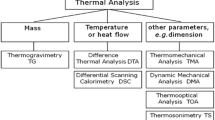Abstract
The two established thermal properties of enzymes are their activation energy and their thermal stability. Arising from careful measurements of the thermal behaviour of enzymes, a new model, the Equilibrium Model, has been developed to explain more fully the effects of temperature on enzymes. The model describes the effect of temperature on enzyme activity in terms of a rapidly reversible active-inactive transition, in addition to an irreversible thermal inactivation. Two new thermal parameters, T eq and ΔH eq, describe the active–inactive transition, and enable a complete description of the effect of temperature on enzyme activity. We review here the Model itself, methods for the determination of T eq and ΔH eq, and the implications of the Model for the environmental adaptation and evolution of enzymes, and for biotechnology.






Similar content being viewed by others
References
Creighton TE (1993) Proteins. Freeman, New York
Daniel RM, Danson MJ (2001) Assaying activity and assessing thermostability of hyperthermophilic enzymes. Methods Enzymol 334:283–293
Daniel RM, Danson MJ, Eisenthal R (2001) The temperature optima of enzymes: a new perspective on an old phenomenon. Trends Biochem Sci 26:223–225
Eisenthal R, Peterson ME, Daniel RM, Danson MJ (2006) The thermal behaviour of enzymes: implications for biotechnology. Trends Biotechnol 24:289–292
Fulton KF, Devlin GL, Jodun RA, Silvestri L, Bottomley SP, Fersht AR, Buckle AM (2005) PFD: a database for the investigation of protein folding kinetics and stability. Nucleic Acids Res 33:D279–D283
Georlette D, Blaise V, Collins T, D’Amico S, Gratia E, Hoyoux A, Marx JC, Sonan G, Feller G, Gerday C (2004) Some like it cold: biocatalysis at low temperatures. FEMS Microbiol Rev 28:25–42
Hardy WB (1899) On the structure of cell protoplasm. J Physiol 24:158
Hudson RC, Ruttersmith LD, Daniel RM (1993) Glutamate dehydrogenase from the extremely thermophilic archaebacterial isolate AN1. Biochem Biophys Acta 102:244–250
Lee CK, Daniel RM, Shepherd C, Saul DJ, Cary SC, Danson MJ, Eisenthal R, Peterson ME (2007) Eurythermalism and the temperature dependence of enzyme activity. FASEB J 21:1934–1941
Liang Z, Tsigos I, Bouriotis V, Klinman JP (2004) Impact of protein flexibility on hydride-transfer parameters in thermophilic and psychrophilic alcohol dehydrogenases. J Am Chem Soc 126:9500–9501
Lumry R, Eyring H (1954) Conformational changes of proteins. J Phys Chem 58:110
Pace NR (1997) A molecular view of microbial diversity and the biosphere. Science 276:734–740
Peterson ME, Daniel RM, Danson MJ, Eisenthal R (2007) The dependence of enzyme activity on temperature: determination and validation of parameters. Biochem J 402:331–337
Peterson ME, Eisenthal R, Danson MJ, Spence A, Daniel RM (2004) A new, intrinsic, thermal parameter for enzymes reveals true temperature optima. J Biol Chem 279:20717–20722
Schwartzman DW, Lineweaver CH (2004) The hyperthermophilic origin of life revisited. Biochem Soc Trans 32:168–171
Sizer IW (1944) Temperature activation and inactivation of the crystalline catalase–hydrogen peroxide system. J Biol Chem 154:461–473
Thomas TM, Scopes RK (1998) The effects of temperature on the kinetics and stability of mesophilic and thermophilic 3-phosphoglycerate kinases. Biochem J 330:1087–1095
Wachtershauser G (1998) In: Wiegel K, Adams M, (eds) Thermophiles: the keys to molecular evolution and the origin of life? Taylor and Francis, Philadelphia, pp 47–57
Wright GG, Schomaker VJ (1948) Studies on the denaturation of antibody. iii. Kinetic aspects of the inactivation of diphtheria antitoxin by urea. Am Chem Soc 70:356–364
Acknowledgements
We thank the Royal Society of New Zealand’s Marsden Fund and the National Science Foundation (Biocomplexity 0120648) for financial support.
Author information
Authors and Affiliations
Corresponding author
Additional information
Communicated by D.A. Cowan.
Rights and permissions
About this article
Cite this article
Daniel, R.M., Danson, M.J., Eisenthal, R. et al. The effect of temperature on enzyme activity: new insights and their implications. Extremophiles 12, 51–59 (2008). https://doi.org/10.1007/s00792-007-0089-7
Received:
Accepted:
Published:
Issue Date:
DOI: https://doi.org/10.1007/s00792-007-0089-7




